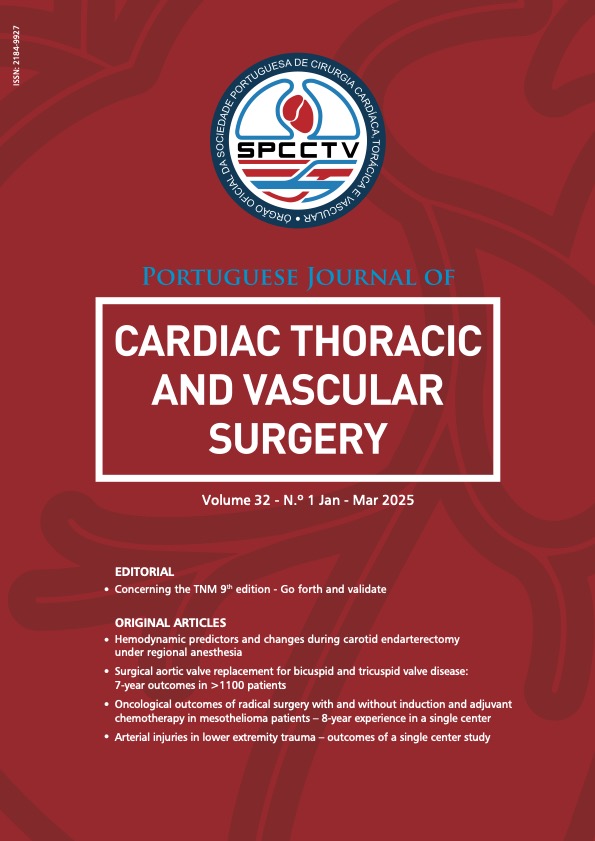Arterial Injuries In Lower Extremity Trauma – Outcomes Of A Single Center Study
DOI:
https://doi.org/10.48729/pjctvs.489Keywords:
Vascular injury, Femoral artery, Popliteal artery, Vascular traumaAbstract
Objectives: Femoropopliteal artery injury is a common and potentially life-threatening form of arterial injury in the lower extremities. Despite advancements in its management, there is still a considerable risk of amputation and death associated with these injuries.Methods: We conducted a retrospective analysis on the patients who received treatment for lower limb trauma and concomitant arterial injury at a Level 1 Trauma Center and aimed to compare patient characteristics, injury severity scores, time to surgery, vascular repair methods, presence of fractures, and sequence of vascular and orthopedic repairs between groups: limb salvage vs amputation and survival vs death. We also aimed to identify factors contributing to amputation and death.
Results: Between January 2020 and June 2023, 21 patients, 71.4% male and 28.6% female patients were treated. 95.2% of the injuries were caused by blunt trauma, and the most commonly injured artery was the popliteal artery, in 61,9% of the cases. MESS scores were significantly higher in patients who died (p=0.012) and the presence of an exposed fracture was more common in patients who underwent amputation (p=0.004). 23,8% of patients were submitted to above knee amputation and a death rate of 19% was observed.
Discussion/Conclusion: When dealing with multiple injured limbs, the treatment approach and priorities are still under discussion, typically customized based on individual clinical situations. Our study underscores the significance of promptly performing vascular repair, reducing time delays, and taking into account bone and soft tissue injuries in the treatment strategy.
Downloads
References
Asensio JA, Kunch EJ, Garcia-Nunez LM, Petrone P. Femoral vessel injuries: analysis of factors predictive of outcomes. J Am Coll Surg. 2006;203:512-520.
Perkins ZB, Yet B, Glasgow S, Cole E, Marsh W, Broth K, et al. Meta-analysis of prognostic factors for amputation following surgical repair of lower extremity vascular trauma. Br J Surg. 2015;102:436-450.
K Kauvar DS, Sarfati MR, Kraiss LW. National trauma databank analysis of mortality and limb loss in isolated lower extremity vascular trauma. J Vasc Surg. 2011;53:1598-1603.
Mullenix PS, Steele SR, Andersen CA, Stames BW, Salim A, Martin MJ. Limb salvage and outcomes among patients with traumatic popliteal vascular injury: an analysis of the National Trauma Data Bank. J Vasc Surg. 2006;44:94-100.
Micari A, Sbarzaglia P, Meeks MD, et al. New imaging modalities in peripheral interventions. Eur Heart J Suppl. 2015;17 (Suppl A):A18-22.
Baghi I, Hefafatar MR, Shokrgozar L, et al. Assessment of vascular injuries and reconstruction. Trauma Mon. 2015;20(4):e30469.
Jagdish K, Paiman M, Nawfar A, et al. The outcomes of salvage surgery for vascular injury in the extremities: A special consideration for delayed revascularization. Malays Orthop J. 2014;8(1).
Copes WS, Champion HR, Sacco WJ, Lawnick MM, Keast SL, Bain LW. The Injury Severity Score revisited. J Trauma. 1988;28:69-77.
Hellet DL, Howey T, Sanders R, Johansen K. Limb salvage versus amputation. Preliminary results of the Mangled Extremity Severity Score. Clin Orthop Relat Res. 1990;(256):80-86.
Almasri J, Adusumalli J, Asi N, Lakis S, Alsavas M, Prokop LJ, Bradbury A, Kolh P, Conte MS, Murad MH. A systematic review and meta-analysis of revascularization outcomes of infranquinal chronic limb-threatening ischemia. J Vasc Surg. 2018 Aug;68(2):624-633. doi: 10.1016/j.jvs.2018.01.066. Epub 2018 May 24. PMID: 29804736.
Section 2: Limb Salvage and Amputation After Major Lower Limb Trauma. J Orthop Trauma. 2017 Apr;31 Suppl 1:S39. doi: 10.1097/BOT0000000000000797. PMID: 28323800.
Kumar MK, Badole C, Patond K. Salvage versus amputation: Utility of mangled extremity severity score in severely injured lower limbs. Indian J Orthop. 2007 Jul;41(3):183-7. doi: 10.4103/0019-5413.33679. PMID: 21139741; PMCID: PMC2989115.
Shawen SB, Keeling JJ, Branstetter J, Kirk KL, Ficke JR. The mangled foot and leg: salvage versus amputation. Foot Ankle Clin. 2010 Mar;15(1):63-75. doi: 10.1016/j.fcl.2009.11.005. PMID: 20189117.
Mitchell SL, Hayda R, Chen AT, Carlini AR, Ficke JR, MacKenzie EJ; METALS Study Group. The Military Extremity Trauma Amputation/ Limb Salvage (METALS) Study: Outcomes of Amputation Compared with Limb Salvage Following Major Upper-Extremity Trauma. J Bone Joint Surg Am. 2019 Aug 21;101(16):1470-1478. doi: 10.2106/JBJS.18.00970. PMID: 31436655; PMCID: PMC7406140.
Downloads
Published
How to Cite
License
Copyright (c) 2025 Portuguese Journal of Cardiac Thoracic and Vascular Surgery

This work is licensed under a Creative Commons Attribution 4.0 International License.





